What is toenail fungus
Fungal nail plates on the toes is an infectious disease with a chronic form of course that occurs as a result of infection of this part of the extremity with pathogens (fungi). In medical terminology, this pathology is called onychomycosis.
It is considered a common disease that is difficult to treat with all kinds of therapies.On average, every 10th inhabitant suffers from toenail fungus. The disease can turn into complicated forms, completely affecting the entire surface of the nail plate, causing its detachment and deformation.
Types of toenail fungus
Treatment of toenail fungus with folk remedies is a long process, and a positive result can be obtained after 1-3 months. from the beginning of therapy. The diversity of mycosis is also of great importance, the development of which has led to the defeat of all or part of the nail plate.
The following table shows the types of toenail fungus and a description of the pathological process:
| Type of onychomycosis | Features of the disease |
| Normotrophs | The color of the nail plate changes. Elongated streaks and irregular spots may appear. At the same time, the usual gloss of the nail, the transparency of the plate and its normal thickness are preserved. It is considered a non-serious disease that responds well to treatment with traditional medicine. |
| Hypertrophic | The color of the nail changes, its shine and transparency are lost. With the destruction of the edges, there is a gradual deformation of the nail plate. Peeling off part of the nail from the bed is possible. The degree of deformation of the plate depends directly on the insemination of the tissue by pathogenic microorganisms. |
| Onycholytic | This is an atrophic type of the disease, when the stage of deformation of the nail plate is completed. The tissue of the nail dies, which ultimately leads to its rejection from the root of the bed. |
This classification of the biodiversity of onychomycosis is used by dermatologists.
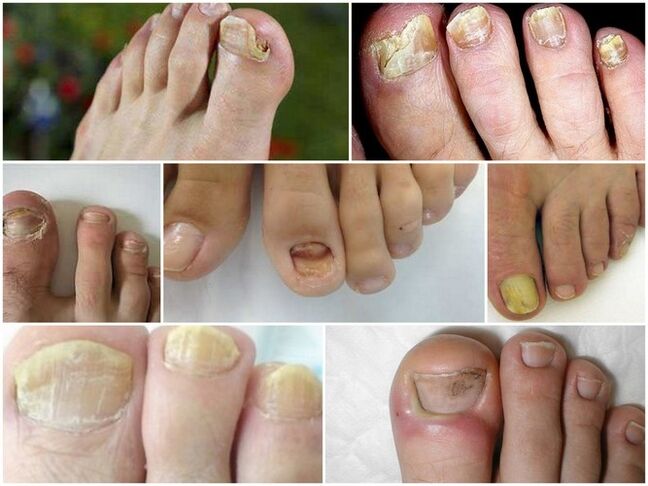
In addition, the disease is divided according to the symptoms of the clinical picture, namely:
- distal - Damage to the nail plate occurs only on the side of the free edge.
- lateral - the destruction of the nail develops on the sides;
- proximal - mycosis destroys the tissues of the posterior ridge;
- total - The fungus has completely attacked the entire nail from the root to the front.
The type and form of the disease are determined by a specialist at the time the patient is examined. Based on the results of the examination and diagnosis, a treatment regimen is selected. This applies to both drug therapy methods and folk remedies.
Stages and degrees of toenail fungus
Toenail fungus, a folk remedy treatment that lasts for a long time, is a chronic disease. Onychomycosis develops over several months and sometimes even over many years. This depends on how strong the patient's immune system is and how heavily the infectious pathogen is contaminated.
Each stage of the disease is characterized by a gradual deterioration in the health of the affected tissues, namely:
- 1st stage - there is a gradual change in the shade of the color of the nail plate along the edges, the formation of stripes and spots of white, gray or yellow tones is possible, other painful signs of the disease are completely absent (a personfeels a sharp and unpleasant yeast odor coming from the toes);
- 2nd stage - onychomycosis progresses and covers the entire area of the nail plate, the structure of which begins to change from the edges to the base of the bed (the color of the diseased tissue is completely yellow or gray, no signs of transparency);
- 3rd stage - the final stage in the development of toenail fungus, which is characterized by complete necrosis of the affected tissues. They are deformed and rejected by the body (the appearance of local inflammation caused by the peeling of the nail plate from the base of the bed is possible).
The last stage of the disease is the most severe form of onychomycosis. After the nail is rejected, it will regenerate, but in this case healthy tissue will already be formed. If a person does not take measures to treat a dermatological disease and eliminate pathogenic microorganisms, then the new nail will also be infected with mycoses and destroyed to the ground.
Toenail fungus symptoms
Toenail fungus, the treatment of which with folk remedies requires the regular use of homemade decoctions, tinctures and ointments, is a disease with pronounced symptoms.
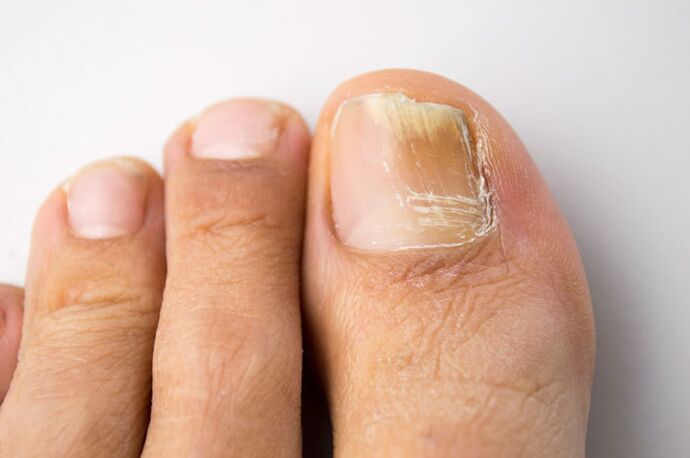
The onychomycosis of this part of the body can be recognized by the following symptoms:
- Reddening of epithelial tissues on the perimeter of the nail plate;
- white spots or stripes appear on the sides of the nail, as well as on the side of its front, which do not go away during the processing of the plate or performing water procedures;
- the nail plate gradually changes color, there is a loss of its transparency (the pathological process develops from the edges to the center and root of the tissue);
- Fungal microorganisms penetrate deeply into the nail plate and destroy its structure, which leads to its deformation.
- The affected nail has a yellow, wrinkled shape.
- are separated from the nail bed with mechanical action on the affected tissue (this process can be accompanied by painful symptoms and the secretion of ichor in the nail root, where it connects with the epithelial and soft tissues of the toe).
All of the above symptoms are accompanied by the constant persistence of a pungent and unpleasant odor, similar to yeast, but more pronounced. This sign of the disease appears even before external symptoms develop, which indicates a gradual destruction of the tissues of the nail plate.
Causes of toenail fungus
Fungi on the toenails, the treatment of folk remedies for which is based on the principle of systemic use of home medicines, can not develop on their own without the influence of a number of factors.
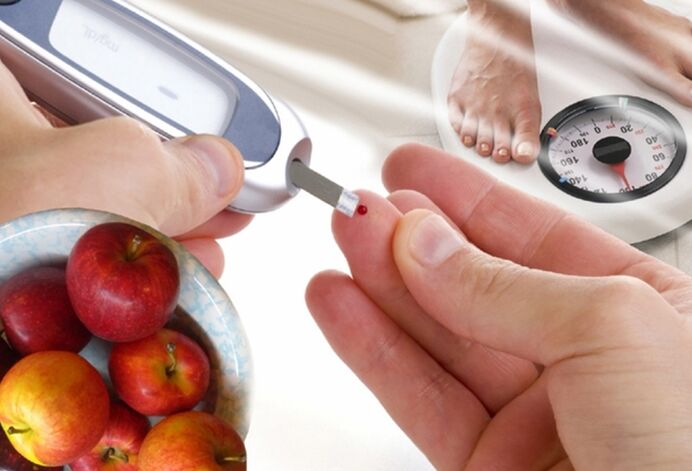
An infection with onychomycosis is possible in the following cases:
- came into contact with a surface containing viable spores of fungal microorganisms as a result of visiting public showers, baths, steam rooms, swimming pools, and saunas when a person was not using individual rubber slippers;
- multiple people wearing shoes together if one of them has mycotic lesions of the nail plates;
- poor hygiene, occasional foot washing;
- the presence of comorbidities such as diabetes mellitus, varicose veins, as well as foot deformities increases the risk of toenail fungus if local immunity is decreased or a nutrient medium is created to increase the population of fungal microorganisms;
- wears shoes made with a poor quality coating that does not allow air to pass through and does not absorb water, which ultimately leads to the toes being constantly damp;
- Contact of the open part of the foot or nail with the floor surface in the apartment if a person with onychomycosis lives in the same living conditions.
A person's immune status plays an important role in the development of this disease. People with strong immunity can avoid infection and further damage to the nail plate. Warm and humid environments are ideal conditions for fungal microorganisms. Therefore, this information should be taken into account when visiting beaches and other crowded places.
Toenail fungus diagnosis
Fungus on the toenails, the treatment of which with folk remedies begins only after a thorough examination by a dermatologist, is an infectious disease that requires careful diagnosis. This is necessary to determine the strain of fungal microorganisms, and then choose a treatment regimen that will be effective in a particular case.
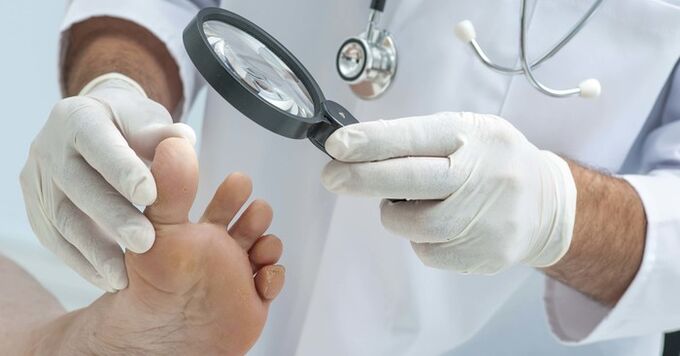
To diagnose onychomycosis, the patient must go through the following examination stages:
- preliminary examination by a dermatologist who will examine the appearance of the affected plate, assess the condition of the tissues and the degree of their deformation;
- a smear is taken from the surface of the epithelium on the perimeter of the nail bed (a biochemical analysis is carried out for a strain of fungal microorganisms, as well as the possible presence of a secondary bacterial microflora);
- In the conditions of the manipulation room of the laboratory, the specialist selects part of the affected tissue in order to study the fungal microorganisms in more detail and exclude the simultaneous presence of several types of mycosis.
- In addition to the toes, an examination of the skin surface of the foot is done to make sure the fungal disease is localized and there are no signs of spreading to other parts of the lower extremity.
Based on the results of an external examination, as well as on the basis of laboratory findings, the attending physician diagnoses the patient's onychomycosis or denies the presence of any pathology.
The diagnosis takes an average of 1 to 3 days. In a public hospital, the services of a biochemical laboratory are free, but the conditions for the study of biological material can drag on for up to 7-10 days.
When should a doctor be consulted?
Consultation with a dermatologist should be carried out as soon as signs of developing nail fungus are observed.The delay is fraught with exacerbation of symptoms and damage to large areas of the nail plate.
In addition, a person with signs of onychomycosis is a carrier of a fungal infection and spreads without realizing it, under the everyday conditions of their stay, spores of pathogenic microorganisms. In this case, infection of healthy family members with onychomycosis cannot be excluded.
Toenail fungus prevention
It is possible to avoid contamination of the toenails with a fungal infection. To do this, however, it is necessary to follow simple prevention rules on a daily basis that protect the lower extremities from fertilization by pathogenic microorganisms.
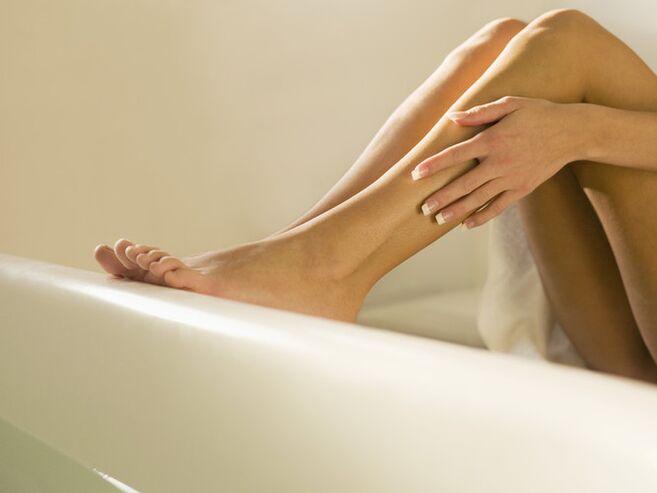
The following actions are recommended:
- Do not visit public baths, swimming pools, saunas, showers and do not wear individual shoes with rubber soles on your feet.
- only wear high quality shoes made of genuine leather;
- observe the rules of personal hygiene, wash your feet daily with warm water and soap, wash socks;
- insists on treating family members who have signs of toenail fungus but are getting on with the disease and not seeking medical help;
- During the summer vacation near open water on the beach, walk only in shoes and avoid contact of the epithelial surface of the feet and toes with sand, river silt, or soil.
- only wear your own shoes;
- Make sure that there are no areas of mold growth in the apartment or private house (moisture on the walls, fungus that has infected old wooden floors, baseboards, blackening of the wallpaper in the corners).
In order to prevent fungal infections of the nails, it is recommended to pay special attention to strengthening the immune system.
To do this, you need to take a contrast shower every day, give up bad habits, harden the body, eat rationally and eat only biologically useful products (cereals, chicken, rabbit, turkey, veal, fresh fruits, vegetables, herbs, Cottage cheese, milk, cheese, sea fish).
Methods of treating toenail fungus
Onychomycosis therapy is carried out using traditional medicines and traditional medical prescriptions, and also according to the method of surgical intervention. Each of these methods is effective at some stage in the development of the disease.
Medicines
The treatment of a fungal infection is carried out with drugs that have an antifungal spectrum of activity.
Antifungal drugs should only be prescribed by a dermatologist. Only a specialist of this profile can determine which drug is effective in a given clinical case. In addition, when drawing up a treatment regimen, the data from laboratory tests on collected samples of a deformed or altered nail are taken into account.
Traditional methods
There are traditional medicine recipes that can help you get rid of a fungal infection of the toenails without the use of pharmaceutical preparations. To do this, use the following compresses, homemade ointments, tinctures, and other methods:
Kombucha compression
To prepare this folk remedy, you need to buy a kombucha or grow it yourself at home. A piece of this ingredient is cut off with a knife and then placed on the surface of the infected nail. The procedure is carried out at night before going to bed. Kombucha is attached to the finger with an adhesive plaster. The time of therapy is not limited in time.
Onion juice tincture
You need to take 1 medium onion, chop it with a knife, then pour 1 tsp. Granulated sugar.
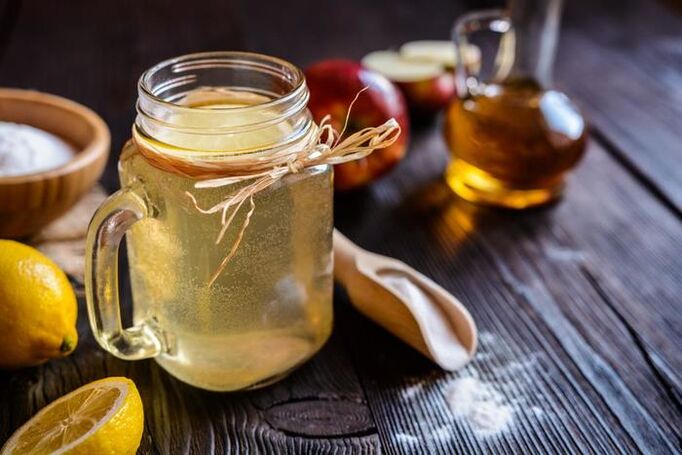
The future medicine is placed in the refrigerator for 24 hours. During this time, the chopped vegetables can release a sufficient amount of juice, which is infused and then used as a medicinal product. A sick nail is wiped with onion juice 3-4 times a day for 3 months or until full recovery.
Antiseptic solution
This product is made at home by mixing in equal proportions of 1 tsp. boiled water, ethyl alcohol and garlic pulp. All components are mixed until a homogeneous mass is formed. The resulting solution is used for antiseptic treatment of the nail plate at least twice a day. Treatment lasts at least 3-4 months.
Salt ointment for mushrooms
A powerful antifungal that is easy to make at home. For this you need to take ½ teaspoon. Table salt, add 1 tbsp. l. Honey collected from herbs, and then mix all the ingredients. The result is a honey-based ointment that contains a high concentration of mineral salt.
The product is applied to the nail plate once a day. It is best to do the procedure at night. During the treatment process, it is necessary to observe precautions so that at home no medicine gets on the skin around the perimeter of the nail bed, and you should also protect the mucous membrane of the eyes.
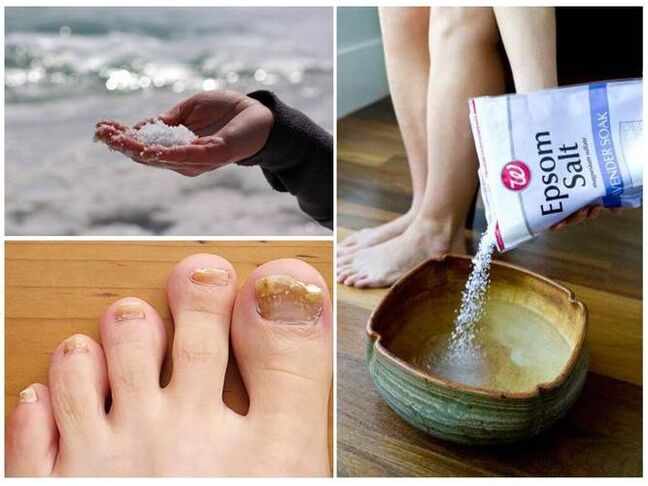
Homemade ointment is used until the diseased nail comes off with the further formation of a healthy plate. Alternative therapy is really effective, but the only drawback to using it is timing of therapy.
The period of use should be at least 3 months. The initial form of fungal infection of the nail plates on the feet can be eliminated within 2 months. In this case, the course of treatment should be continuous. Skipping a single operation can damage tissue health.
Other methods
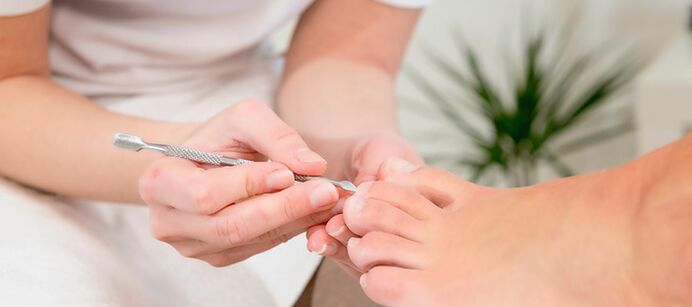
An alternative treatment for a fungal infection of the nails of the lower extremities is surgery. The method consists in the attending physician removing the deformed nail plate.
In general, the operation is performed as follows:
- The patient comes into the operating room independently and then lies down on the couch or sits on a chair.
- A nurse injects a local anesthetic into a finger whose nail has onychomycosis.
- After the anesthetic has started to work (after 5-10 minutes), the surgeon tears off the affected nail plate with tweezers.
- An antiseptic treatment of the operated area is carried out, sutures and a sterile bandage are put on.
After the surgical procedure is complete, the patient is taken to his / her department of the surgical department, where he receives further antifungal therapy. The average time it takes for the wound site to heal completely is 7 to 10 days. Within 1 month. A new nail plate grows, which, provided the treatment process is properly organized, shows no signs of fungus.
Possible complications
If no measures are taken to heal the nail plates from a fungal infection,can develop the following complications caused by pathogenic microorganisms:
- complete deformation of the nail plate with its further detachment from the base of the bed;
- the spread of the fungus to healthy skin tissue on the surface of the foot between the toes, the transition of the disease to the nails of the upper extremities, inguinal folds;
- Infection with onychomycosis in other family members who have not previously had a fungal disease (children are most susceptible because their immune systems are weaker than adults);
- Loss of the nail and termination of the process of forming a new plate, since due to the abundance of infectious microorganisms, the integrity of its structure is initially violated.
Treatment of toenail fungus with folk remedies is possible, but requires a maximum effort of at least 3 months. Time.
The main danger of onychomycosis is that the fungal microorganisms that damage the nail plate are highly infectious and quickly adapt to new environmental conditions and the effects of active ingredient components.
Therefore, treatment of the disease should begin as early as possible to prevent the transition to a complicated or chronic form of the course.































